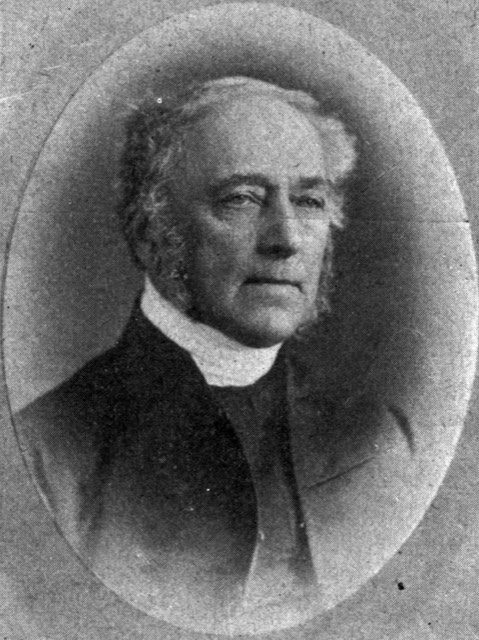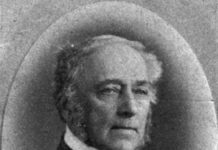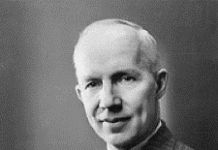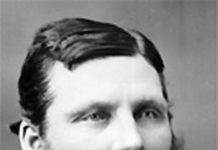by Doug MacDonald

Henry Patton was born in Chelmsford, England, and was educated in England, in Upper Canada at the Cornwall Grammar School, and at the Theological Seminary, Chambly, Lower Canada. From 1821, there were occasional visits from Church of England clergy to Clothier’s Mill. In 1825, Bishop C.J. Stewart, learning of a proposed church in Clothier’s Mill, promised to appoint a missionary. One year later, in 1826, the Church of England established the Pioneer Mission Parish of St. James in the wilderness between the Ottawa and the St. Lawrence, appointing Henry Patton, a youth of twenty, to the Parish. St. James Parish included the Townships of Wolford, Oxford, and South Gower and, north of the Rideau, the Townships of Marlborough and North Gower, a tract of land “forty miles in extent, and from sixteen to twenty-five miles in breadth” – with some seven preaching stations.
There were some families of means, and in Clothier’s Mill Squire William H. Bottum had granted to Lyman Clothier Sr., Trueman Hurd, and Abraham Beach three-fourths of an acre on North Main Street (now Clothier Street West) as the site for a church and burial ground. The earliest internments were Eli and Elias Hurd, who died January 4, 1825, eleven month old twin sons of Abagail and Trueman Hurd.
In early 1827, Henry Patton, with his congregation, began excavating for the stone foundation on which a wood frame church was built. St. James became the first church in the village and in the territory. Patton was one of the most able of the early missionaries and he achieved much in the Parish: the building of the first church in 1827, a second church, Christ Church in Burritt’s Rapids, in 1831 which has survived and continues to open its doors to worshippers. In 1837 he built the original Holy Trinity in Merrickville. Henry was a prominent member of the Board of Trustees that established and built the Kemptville Grammar School in 1843. The school was built on a lot offered by him from the lands owned by the Anglican Diocese.
British Parliamentary grants, the source of funding for the Church of England in British North America, were reduced in 1832 and ended in 1834.
In 1833, Henry Patton married Harriet Amelia Warner. Along with success came heartbreak, three of the Pattons’ infants and one toddler died: Elizabeth in 1834, Andrew in 1836, toddler William Henry in 1841, and James in 1842. On August 17, 1844, Harriet Amelia Patton died. Harriet and the four children are buried in St. James Cemetery.
It was time to move on. Henry Patton was a widower with an eight year-old son, Alfred, and a five year-old daughter, Elvira, when, in 1845, he was appointed to the Parish of Cornwall. Not yet forty, he had in nineteen years at St. James gained a wealth of experience. He had learned his lessons well; he knew the hardships that faced a travelling missionary in a large isolated wilderness parish. He knew the challenges of supporting a family in any degree of comfort while living on a “wretched allowance”, a “miserable pittance”, and being expected to appear a gentleman of birth and education.
In 1846, Patton married Georgiana Dodson and they had four children: Henry L., Merriall, Herbert Bethune, and Francis Lawrence. His career advanced as Rector of Cornwall, Rural Dean of Johnstown in 1849 and, in 1862, sole Archdeacon of the Diocese of Ontario (which then included what is now the Diocese of Ottawa). Influential and respected, Patton was the “eyes” of the Bishop for the huge wedge of Upper Canada from Trenton and Deep River, east to the boundary of Lower Canada. He was an honourable and scrupulous man and an advocate for, and keeper of, the missionary conscience of the Diocese.
On April 30, 1874, Archdeacon Patton died. In Kemptville, at a special Vestry in July, it was agreed to “make an earnest effort to obtain the funds required to erect a neat stone church to the honour of Almighty God and in memory of the late Venerable Archdeacon Patton”. The 1827 St. James was, by the 1870’s, too small for its congregation and the spire, damaged in a gale, was a safety hazard. On August 24, 1874, The Ottawa Free Press reported that John Stannage planned to build a new church “to be called the Archdeacon Patton Memorial Church”. As early as 1873, Stannage had commissioned William Tutin Thomas, one of the foremost architects in Canada, to design and construct a “little cathedral” in memory of the first Rector of the Parish. The Archdeacon Patton Memorial Church was built with funds raised by parishioners, Stannage’s contacts in England, and Patton’s friends and family.
On May 28, 1878, the cornerstone for the new church was laid. Both the handsome exterior of enduring cut limestone, and the simple beauty of the interior are a tribute to, and reminder of, the generations of faithful who’ve gone before us. As keepers of our past, we reflect on the heritage that is the Archdeacon Patton Memorial Church.
Someone asked if there is, among the magnificent stained glass windows, one dedicated to the first Rector of the Parish. There is not, for the St. James Anglican Church itself is the memorial to Henry Patton.








